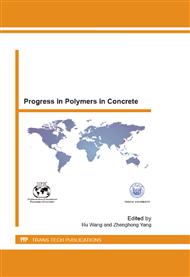p.198
p.204
p.213
p.219
p.229
p.235
p.241
p.249
p.255
The Engineering Properties of Unsaturated Polyester Polymer Concrete Used the Spherical Steel Slag Fine Aggregate
Abstract:
Polymer concrete has high durability, high abrasion resistance, and high strength, compared to ordinary Portland cement concrete. However, because of high cost of binder, it has not been used in construction field generally. The properties of unsaturated polyester polymer concrete used the steel slag fine aggregate of spherical type as an aggregate for polymer concrete in fresh and hardened state were studied. This research shows that the unsaturated polyester polymer concrete have high workability, high strength and low cost due to decreasing the polymer content, when steel slag fine aggregate of spherical type was used.
Info:
Periodical:
Pages:
229-234
Citation:
Online since:
April 2013
Authors:
Price:
Сopyright:
© 2013 Trans Tech Publications Ltd. All Rights Reserved
Share:
Citation:


